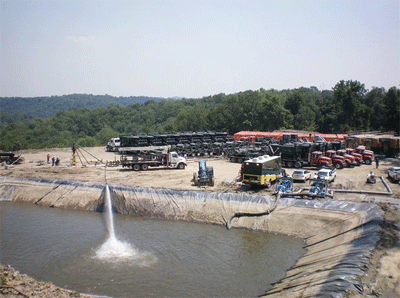Fracturing fluid
From Wikimarcellus
(Difference between revisions)
| Revision as of 19:58, 3 March 2011 Tcopley (Talk | contribs) ← Previous diff |
Revision as of 20:11, 3 March 2011 Tcopley (Talk | contribs) Next diff → |
||
| Line 1: | Line 1: | ||
| - | <center>http://www.sonic.net/~tcopley/img/ECA/reservoir.gif<br>'''Marcellus frac fresh water impoundment in Greene Co., Pennsylvania'''<br>[http://www.energycorporationofamerica.com/ Photo courtesy of Energy Corp. of America]</center> | + | <center>[[Image:reservoir.gif|frame|center|<div align="center">Marcellus frac fresh water impoundment in Greene Co., Pennsylvania'''<br>Photo courtesy of [http://www.energycorporationofamerica.com/ Energy Corp. of America]</div>]] |
| Typical '''drilling fluid''' used for [[Hydro-fracturing|hydro-fracturing]] wells drilled in the [[Marcellus shale]] formation is approximately 99.5% water and sand. The remainder consists of [[Chemicals|chemicals]] that are for the most part non-toxic similar to those used in swimming pools and shampoos. The water, sand and chemicals are trucked in. A typical fresh water impoundment holds 2 to 3 million gallons, but can run as high as 10 million. | Typical '''drilling fluid''' used for [[Hydro-fracturing|hydro-fracturing]] wells drilled in the [[Marcellus shale]] formation is approximately 99.5% water and sand. The remainder consists of [[Chemicals|chemicals]] that are for the most part non-toxic similar to those used in swimming pools and shampoos. The water, sand and chemicals are trucked in. A typical fresh water impoundment holds 2 to 3 million gallons, but can run as high as 10 million. | ||
| [[Category:Drilling practices]] | [[Category:Drilling practices]] | ||
Revision as of 20:11, 3 March 2011

Marcellus frac fresh water impoundment in Greene Co., Pennsylvania
Photo courtesy of Energy Corp. of America
Photo courtesy of Energy Corp. of America
Typical drilling fluid used for hydro-fracturing wells drilled in the Marcellus shale formation is approximately 99.5% water and sand. The remainder consists of chemicals that are for the most part non-toxic similar to those used in swimming pools and shampoos. The water, sand and chemicals are trucked in. A typical fresh water impoundment holds 2 to 3 million gallons, but can run as high as 10 million.

